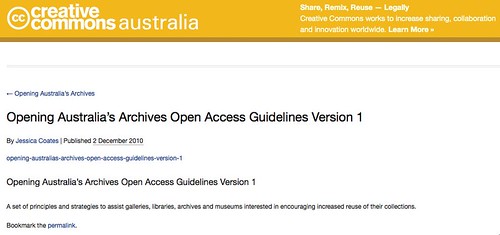I felt the guidelines would be useful if your institution is exploring a Creative Commons (CC) or Open Access policy, and would like to know where/ how to start.
Or simply to go through all critical considerations, in order for the institution to make an informed decision whether to adopt a CC/ Open Access policy, or not.
The document also describes examples of institutions that have adopted CC/ Open Access (see the Case Studies section).
The 38-page* document is licensed under a Creative Commons Attribution 3.0 Australia licence.

*It's 38 pages when I opened with Open Office, which seem to have different pagination.
From its Introduction:
The Opening Australia's Archives project aims to address this problem by working with Australia’s collecting institutions to increase the public’s ability to access and reuse our national collections. Run by the Innovation Law program of the ARC Centre of Excellence for Creative Industries and Innovation at Queensland University of Technology the project encourages the adoption of open access approaches through coordinated policy, implementation and advocacy initiatives across the collecting sector.
Opening Australia’s Archives: Open Access Principles for Australian Collecting Institutions were prepared in consultation with representatives of the Australian collecting sector commencing with a series of meetings held nationally during 2009. For more information on the meetings, principles and project see the Opening Australia's Archives website.
The document explicitly states that it is not meant to be prescriptive:
They are suggestions only, drawing on approaches already being used by collecting institutions in Australia and internationally, and may not be appropriate for all situations. (p10/ 11)
I found the document very readable.
Practical too.
The coverage seems comprehensive. Enough to anticipate pertinent operational issues in the institutional adoption of CC/ Open Access. That's what struck me, as I think back on how some of my colleagues and I attempted a similar assessment recently. This set of guidelines would have helped a lot (as for the said 'assessment' in question, it shall be revealed in due time).
For instance, the section on "Easy first steps" suggests:
- "Start with low-risk steps, such as marking public domain material on your website as free for reuse"
- "Identify materials that the institution owns the copyright of and release them under broad terms of use (such as a Creative Commons licence)"
- "Identify materials within your collection that have a single, easily locatable copyright owner..."
- "Incorporate an optional public access licence into your collection agreement"
The 'practical' part comes across like these two examples (from the "writing institutional policy" section):
- Establish ‘notice and takedown’ procedures for dealing with requests to remove material from an institutional website. This should include clear guidelines on the circumstances in which it is appropriate for material to be removed (eg copyright infringement, cultural sensitivity etc) and the circumstances in which it is not.
- ... Having some material available for open access – even if it is not complete or of the highest quality – is better than none.
Other subsequent sections spell out principles for practical and operational matters. Like these section headers:
- When developing terms of use for online material
- When responding to permission inquiries (btw, it mentions about how to save administrative time for public enquiries on permissions for re-use(
- When collecting material
- When providing access to material
- When dealing with orphaned works
- When writing institutional policies
- When considering business models (i.e. how to sustain the open access service)
- For sector-wide collaboration
The document continues with case studies of "successful and best practice open access projects, or projects relevant to open access around Australia and internationally".
The cases include those from Australian local/ state and national institutions. International case studies include Flickr Commons, The Brooklyn Museum, Massachusetts Institute of Technology OpenCourseWare, Bundesarchiv (German Federal Digital Picture Archives), the Dutch Tropenmuseum, Project Guttenberg, The Smithsonian (also links to the Smithsonian Institution Web and New Media Strategy wiki.
It occurred to me that it's not just public or government institutions that might find this set of guidelines useful.
Maybe in the near future, we'll see a private/ commercial enterprise start a CC/ Open Access project, as part of their Corporate Social Responsibility.

No comments:
Post a Comment
Join the conversation. Leave a comment :)
Note: only a member of this blog may post a comment.